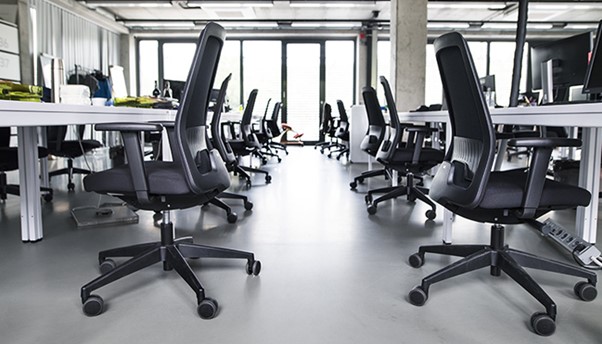The office chair is something most people used to take for granted as part of their working day.
When we started working from home during the pandemic, many of us realised very quickly just how important the ergonomic design is to give you the necessary postural support, but it took decades of evolution before this office staple became an ergonomic solution to the aches and pains caused by bad posture.
In technical terms, office chairs are part of a special category of furniture. Today, they normally have lumbar support, wheels and a loadbearing, gas-lifted leg that allows workers to position their seat in the healthiest, most comfortable position.
Who invented the office chair?
The first documented chairs used in the workplace date from 1900 BC in Egypt. Artisans sat on special tilted stools to carry out their work, with the seats designed in such a way that the workers could lean forward in the posture they typically required, without being uncomfortable. Although they weren’t strictly office chairs, they were designed for the workplace. After drawings and sculptures of the tilted stools used during the 12th Dynasty were discovered in Egypt, scholars realised the angle helped the artisans to do their work comfortably.

In modern times, the first actual office chair was invented by Charles Darwin, the English naturalist and biologist, in the early 1840s. He created the “wooden armchair on wheels” by attaching castors to the cast-iron legs of the chair. This allowed him to manoeuvre around his workspace more easily to access his specimens.
Improving comfort
The growth of rail transport in the mid to late 19th century enabled businesses to expand and employ more staff. There was an increase in the number of clerical staff, who sat down for most of the day. They called for more comfortable office chairs, with features that improved their working life.
American inventor Thomas Warren designed the ground-breaking Centripetal Spring Armchair in 1849. With velvet upholstery, cast-iron legs and a “skirt” concealing the springs under the seat, it featured an innovative swivel mechanism and castors, so office workers could reach things more easily without having to stand up.
Larkin chair
In 1904, Frank Lloyd Wright designed his famous Larkin Building chair to help typists with posture and comfort. Unfortunately, it tended to tip over, with the user ending up on the floor, and was given a rather unfortunate nickname, the “suicide chair”. The flawed engineering was as useful as the success stories, as it told future designers what NOT to do when making office chairs.
Throughout the 20th century, numerous designs for office chairs emerged, including the famous Pivot Armchair Cast Base on Castors known as PACC in 1954. The unique chair, designed by Charles and Ray Eames, was made of moulded fibreglass and plastic. It brought a splash of colour to drab offices.
Ergonomic designs
It wasn’t until the 1970s that designers made ergonomics the primary consideration when it came to office furniture. Bold colours and aesthetically pleasing designs were all well and good – but if they weren’t comfortable or fit for purpose, they were of little use!
In the early 1970s, Giancarlo Piretti and Emilio Ambasz designed the Vertebra Chair – one of the first automatically adjustable office chairs on the market. It was designed to keep the spine in a comfortable position.
This was followed by the launch of the famous Ergon Chair, designed by Bill Stumpf, of the Herman Miller design studio. A pioneering design, it was the first office chair that truly improved comfort and maintained physical health. The foam-filled back and seat provided the most complex spine support in history, the legs had easy-glide castors and the gas-lift levers enabled the user to adjust the tilt and height.
Stumpf had analysed office workers’ movements using photographs and studied orthopaedics to create the chair, using the new science of ergonomics. He increased the height adjustment to make them more comfortable for shorter female workers – older chairs would rarely go any lower than 18 inches.
In 1994, Herman Miller designed another pioneering chair as the tech boom of the 1990s grew. The studio’s Aeron Chair was again created by Stumpf, who collaborated with fellow designer Don Chadwick. The chair’s most innovative features were a reactive tilt as the user moved, and a “pellicle” mesh back to support the spine and help regulate body temperature – keeping you cooler.
21st-century designs
Office chairs have continued to evolve during the 21st century. In 2013, Steelcase launched its Gesture Chair, after completing a Global Posture Study to find out how office workers were using their workspace. The survey revealed the more varied selection of technological devices in the modern office had led to employees adopting nine new postures.
The chair provided a more flexible, supportive, adaptable seat. Featuring adjustable seat-depth, a weight-activated mechanism, mesh-back lumbar support and 360-degree arm movement, the back and the seat moved together as a synchronised system. It was described as the perfect ergonomic office furniture solution.
Towards the end of 2018, Steelcase launched its latest SILQ Chair, which could adapt to the users’ body and natural movements without the use of any knobs or levers. The seating solution is personalised to every individual user for total comfort and support.
Office furniture has come a long way since the days of tilted stools, and modern workers expect a seating solution that won’t adversely affect their posture and wellbeing in the future. In the UK, the government introduced the Virtual Display Unit Health and Safety at Work Legislation in 1992 to ensure office workers’ comfort and safety. It covers the whole office environment, recognising that sitting for long periods can adversely affect workers’ health, causing aches in the back, neck, shoulders, and muscles.
© BE.Spoke & Halfpoint / Adobe Stock
